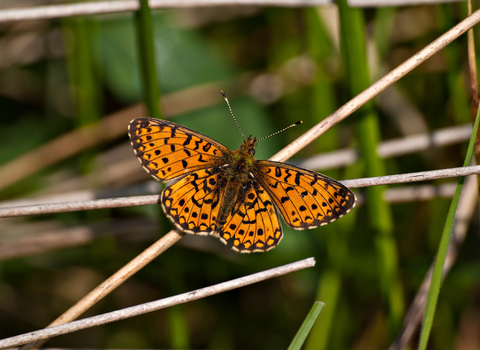
©Bob Coyle
Small pearl-bordered fritillary
The small pearl-bordered fritillary is a pretty orange-and-brown butterfly of damp grassland, moorland, and open woodland. It gets its name from the row of 'pearls' on the underside of its hindwings.
Enw gwyddonol
Boloria selenePryd i'w gweld
May to AugustTop facts
Categori
Stats
Wingspan: 3.5-4.4cmPriority Species under the UK Post-2010 Biodiversity Framework.
Ynghylch
The small pearl-bordered fritillary is widespread and sometimes abundant in Scotland and Wales, but has undergone severe declines. It occurs in damp, grassy habitats, as well as in woodland clearings and on moorland. The adults fly low to the ground using a flutter-and-glide pattern, stopping to nectar at bramble and thistle flowers. The caterpillar feeds on violets, typically common dog-violet and marsh violet.What to look for
The small pearl-bordered fritillary is an orange butterfly with black marks on the upperside of the wings. It has black-and-silver markings on its underside, along with a row of white 'pearls' on the outer edge of the wing. It can be confused with the pearl-bordered fritillary, which is similar in size and appearance. They are most easily distinguished by their undersides - each has a row of seven pearls, but the pearl-bordered Fritillary exhibits two very distinct additional pearls, while the small pearl-bordered fritillary has a colourful mosaic of white, orange and brown markings.Where to find
Mainly found in western areas of the UK, with strongholds in Scotland, Wales and South West England.Roeddech chi yn gwybod?
The small pearl-bordered fritillary first emerges in southwest England in May. The timing of emergence moves gradually northwards, and it does not appear until June in Scotland. Its early appearance in the south means a second brood is possible.Gwyliwch
Small pearl-bordered fritillary (https://vimeo.com/478441228)
Small pearl-bordered fritillary ©Tom Hibbert
